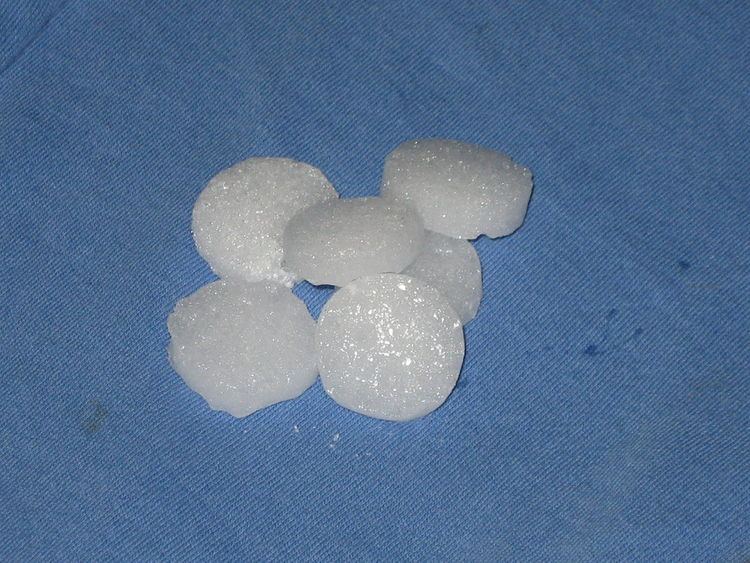 | ||
Mothballs are small balls of chemical pesticide and deodorant, sometimes used when storing clothing and other articles susceptible to damage from mold or moth larvae (especially clothes moths like Tineola bisselliella). Use of mothballs when clothing is stored out-of-season has given rise to the colloquial usage of the terms "mothballed" and "put into mothballs", to refer to anything which is put into storage or whose operation is suspended.
Contents
Composition
Older mothballs consisted primarily of naphthalene, but due to naphthalene's flammability, many modern mothball formulations instead use 1,4-dichlorobenzene. The latter formulation may be somewhat less flammable, although both chemicals have the same NFPA 704 rating for flammability. The latter chemical is also variously labeled as para-dichlorobenzene, p-dichlorobenzene, pDCB, or PDB, making it harder to identify unless all these synonyms are known to a potential purchaser. Both of these formulations have the strong, pungent, sickly-sweet odor often associated with mothballs. Both naphthalene and 1,4-dichlorobenzene undergo sublimation, meaning that they evaporate from a solid state directly into a gas; this gas is toxic to moths and moth larvae.
Naphthalene and 1,4-dichlorobenzene should not be used together because the mixture may cause damage to items being preserved.
Due to the health risks of 1,4-dichlorobenzene, and flammability of naphthalene, other substances like camphor are sometimes used (though camphor has its own toxicity issues).
Uses
In addition to repelling or killing insects such as moths and silverfish, mothballs have been suggested as a repellent to keep away mice, snakes, or other pests, and for use as a stovepipe cleaner. Older-formula mothballs have also been used by drag racers to enhance the octane rating of fuel, by dissolving the mothballs in some of the fuel and filtering out the remains with a filter paper.
Efficacy
Some have claimed mothballs are ineffective as snake repellents or as rodent repellents. Mothballs, however, continue to be advertised as a squirrel repellent and are an ingredient in some commercial repellent products. They are generally ineffective as a deterrent to prevent squirrels from nesting in building interiors.
In the MythBusters episode "Scuba Diver, Car Capers" (2004), it is shown to be "plausible" that adding mothballs to a car's fuel tank would increase its horsepower.
Health risks
The US Department of Health and Human Services (DHHS) has determined that 1,4-dichlorobenzene "may reasonably be anticipated to be a carcinogen". This has been indicated by animal studies, although a full-scale human study has not been done. The National Toxicology Program (NTP), the International Agency for Research on Cancer (IARC) and the State of California consider 1,4-dichlorobenzene a carcinogen.
Exposure to naphthalene mothballs can cause acute hemolysis (anemia) in people with glucose-6-phosphate dehydrogenase deficiency. IARC classifies naphthalene as possibly carcinogenic to humans and animals (see also Group 2B). IARC points out that acute exposure causes cataracts in humans, rats, rabbits, and mice. Chronic exposure to naphthalene vapors is reported to also cause cataracts and retinal hemorrhage. Under California's Proposition 65, naphthalene is listed as "known to the State to cause cancer".
Research at the University of Colorado at Boulder revealed a probable mechanism for the carcinogenic effects of mothballs and some types of air fresheners.
1,4-Dichlorobenzene is a neurotoxin. It has been abused as an inhalant, causing a variety of neurotoxic effects.
Mothballs containing naphthalene have been banned within the EU since 2008.
Alternatives
As discussed in more detail at Tineola bisselliella#Pest control, alternatives to mothballs to control clothes moths include dry cleaning, freezing, thorough vacuuming, or washing in hot water. Camphor is also used as a moth repellent, particularly in China. Unlike naphthalene and dichlorobenzene, camphor has medicinal applications and is not regarded as a carcinogen, though it is toxic in large doses.
Pheromone traps are also an effective tool used when attempting to protect valuable clothing.
